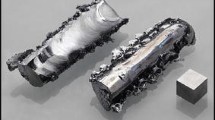Abstract
The stoichiometry of the redox reaction of caffeic acid with iron(III) was determined at pH 2.5. A linear increase in the yield of iron(II) was found with increasing iron(III) concentration until reached constant values when iron(III)/caffeic acid molar ratios were higher than 9. The reaction proceeds through two steps each having different rates, and involving intermediates with different redox activities. A mechanism of the redox reaction consistent with our results is proposed.
Similar content being viewed by others
References
Brown J C 1969 Agricultural use of synthetic metal chelates. Soil Sci. Soc. Am. Proc. 33, 59–61.
Brown J C and Ambler J E 1973 “Reductans” released by roots of Fe-deficient soybeans. Agron. J. 65, 311–314.
Deiana S, Gessa C, Solinas V, Piu P and Seeber R. 1989 Analytical study of the interactions of D-galacturonic acid with iron(III) and iron(II) in solution and with iron(III)-bentonite. Anal. Chim. Acta 226, 315–322.
Deiana S, Gessa C, Piu P and Seeber R 1991a Iron(III) reduction by D-galaturonic acid. Part III. Influence of the presence of additional metal ions and 2-amino-2-deoxy-D-gluconic acid. J. Chem. Soc. Dalton Trans. 1237–1241.
Deiana S, Gessa C, Piu P, Seeber R and Usai M 1991b Analytical study of the reduction of chromium(VI) by D-galacturonic acid. Anal. Chim. Acta 248, 301–305.
Gessa C, Deiana S and Marceddu S 1989 Fibrillar structure of Ca-polygalacturonate as a model for a soil-root interface: Metal ion absorption and its effect on the free space volume of the system. In Plant Membrane Transport: The Current Position. Eds. J Dainty, M J De Michelis, E Marrè and F. Rasi. Caldogno. pp 615–616. Amsterdam.
Gessa C and Deiana S 1990 Fibrillar structure of Ca-polygalacturonate as a model for a soil-root interface. Part I. A hypothesis of the arrangement of the polymeric chains inside the fibrils. Plant and Soil 129, 211–217.
Gessa C, Deiana S, Marchetti M, and Usai M 1990 Complexation and redox reactions in the soil-root interface. Proc. “Stress Ambientali nei Vegetali” Roma. pp 136–142.
Gessa C and Deiana S 1990 Transfer of metal ions in the soil-root interface: Influence of copper(II) on the stability of the fibrils. Giornale Bot. It. 124, 191–193.
Gessa C and Deiana S 1992 Fibrillar structure of Ca-polygalacturonate as a model for a soil-root interface. II. A comparison with natural root mucilage. Plant and Soil 140, 1–13.
Gessa C, Deiana S, Manunza B and Usai M 1991 Transfer of metal ions at the soil-root interface: Role of VO(IV) on Fe(III) mobilization from a Fe(III)-network. Giornale Botanico Italiano 125, 476–478.
Laird T 1979 Quinones In The Synthesis and Reactions of Organic Compounds. Vol. 1, Ed. J F Stoddart. pp 1213–1227. Pergamon Press, Oxford, UK.
Lehmann R G, Cheng H H and Hersch J B 1987 Oxidation of phenolic acids by soil iron and manganese oxides. Soil Sci. Soc. Am. J. 51, 352–356.
Mench M, Morel J L, Guckert A and Guillet B 1988 Metal binding with root exudates of low molecular weight. J. Soil Sci. 39, 521–527.
Olsen R A, Bennet J H, Blume D and Brown J C 1981 Chemical aspects of the Fe stress response mechanism in tomatoes. J. Plant Nutr. 3, 905–921.
Olsen R A, Brown J C, Bennet J H and Blume D 1982 Reduction of Fe(III) as it relates to Fe chlorosis. J. Plant Nutr. 5, 433–445.
Römheld W and Marschner H 1983 Mechanism of iron uptake by peanut plants. I. Fe(III) reduction, chelate splitting, and release of phenolics. Plant Physiol. 71, 949–954.
Whitehead D C, Dibb H and Hartley R D 1981 Extractant pH and the release of phenolic compounds from soils, plant roots and leaf litter. Soil Biol. Biochem. 13, 343–348.
Whitehead D C, Dibb H and Hartley R D 1983 Bound phenolic compounds in water extracts of soils, plant roots and leaf litter. Soil Biol. Biochem. 15, 133–136.
Author information
Authors and Affiliations
Rights and permissions
About this article
Cite this article
Deiana, S., Gessa, C., Manunza, B. et al. Mechanism and stoichiometry of the redox reaction between iron(III) and caffeic acid. Plant Soil 145, 287–294 (1992). https://doi.org/10.1007/BF00010357
Received:
Issue Date:
DOI: https://doi.org/10.1007/BF00010357




